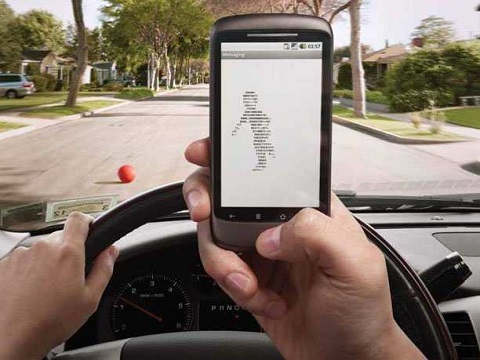Published May 3, 2016, Los Angeles Daily Journal – Would you believe that after all the fatalities, all the media attention and all the pain suffered by scores of families, four states still find it perfectly acceptable for motorists to text and drive? Arizona, Montana, Texas and Missouri have yet to come to the realization that distracted driving is the biggest killer of them all.
Drinking and driving is public enemy number one, but the truth is that texting and driving is infinitely more deadly. The National Highway Traffic Safety Administration (NHTSA) reports that drivers take their eyes off the road for an average of 4.6 seconds when sending or receiving a text. Put in terms of physics, at 80 miles per hour that is the equivalent of driving 539 feet, or nearly two football fields — blindfolded.
The epidemic, and yes it is an epidemic, is as serious as they come. NHTSA studies reveal that 17 percent of all traffic accidents involve texting and driving. Said another way, by the end of the day another 16 Americans will tragically, and unnecessarily, lose their lives to it. The federal agency has determined that texting and driving is six times more dangerous than drinking and driving.
Yet in spite of these rather alarming statistics, few states have enacted any measures designed to stomp out the problem. Save Alaska, which imposes a $10,000 fine for texting and driving, no state has given the problem the attention it deserves. In California, for instance, the fine for texting while driving is $20. The statistically less dangerous offense of drinking and driving, on the other hand, slaps offenders with suspended drivers’ licenses, fines of up to $3,600, alcohol school, skyrocketing insurance and up to six months’ imprisonment.
In recent proposed legislation, however, New York is taking a serious stab at cracking down on the problem — with questionable constitutionality. New York state assembly bill A08613, if passed, would allow police officers to search cellphones of motorists involved in automobile accidents, without a warrant, to see if they were using their phones around the time of the crash. Motorists who refuse to surrender their phones would face a revocation of their drivers’ licenses for up to one year and a $500 fine.
Referred to as Evan’s Law, a respect to the 19-year-old who was killed by a distracted driver, the bill does not specify exactly how the cellphones will be searched. The New York Legislature stated, however, that technology is being developed by the Israeli company Cellebrite which would allow police officers to scan cellphones to determine the traffic on the phone, without actually viewing any of the user’s personal content.
While certainly relevant to the consideration of traffic accidents, the proposed legislation is sure to ignite a firestorm of controversy. In 2014, the U.S. Supreme Court handed down the seminal case of Riley v. California, where the court unanimously ruled that police may not search the cellphones of criminal suspects upon arrest without a warrant, finding that any such search violates the Constitution’s Fourth Amendment prohibiting unreasonable searches and seizures.
Under the Supreme Court’s current interpretation of the Fourth Amendment, police officers may search a criminal suspect’s personal items that are incident to the arrest, such as wallet or briefcase, if they have probable cause to believe that a crime has been committed, the officers’ safety is at issue and it will prevent the destruction of evidence.
Cellphones, however, are manifestly different. As Chief Justice John Roberts wrote, “Cell phones differ in both a quantitative and qualitative sense from other objects that might be kept on arrestee’s person … Many of these devices are in fact minicomputers” that “could just as easily be called cameras, video players, rolodexes, calendars, tape recorders, libraries, diaries, albums, televisions, maps, or newspapers.”
Central to the court’s opinion was the consideration that “the sum of an individual’s private life can be reconstructed” by searching through their cellphone. The New York legislation, however, which only authorizes the scanning of cellphones to determine traffic — not content — may be seen as different.
Proponents of the legislation claim that the accessing of traffic, not content, avoids the concerns and potential legal challenges based on privacy rights or claims of unlawful search and seizures. The strength of that argument remains to be seen. There are no assurances, for instance, that once in possession of the driver’s cell phone, the police officer won’t access the legions of photographs, videos, emails and text messages on the phone, all of which are personal to the user.
And, what’s worse, the Supreme Court’s tolerance for warrantless searches extends only to suspected criminal conduct. The New York legislation applies to all motorists involved in traffic accidents, regardless of who was at fault, and regardless of whether any criminal conduct is suspected.
Absent drastic action, there is no easy answer to the riddle of how to curb texting and driving. It is a crisis of national proportions that is getting worse by the day – and with no end in sight. The current system of powder-puffing drivers with meaningless $20 fines is a having no affect at all. Although it dances on the edges of what is constitutionally acceptable, New York’s proposed legislation at least makes an effort at holding people responsible for the troubling conduct.
In truth, Congress should take the drastic action of requiring that all cell phones sold in the U.S. be equipped with text disabling devices. The technology exists to disallow texting and emailing while on the highway; the decision to impose it is a matter of desire, not ability. There is just no other solution that will arrest the problem, and rid our highways of this reckless conduct.
